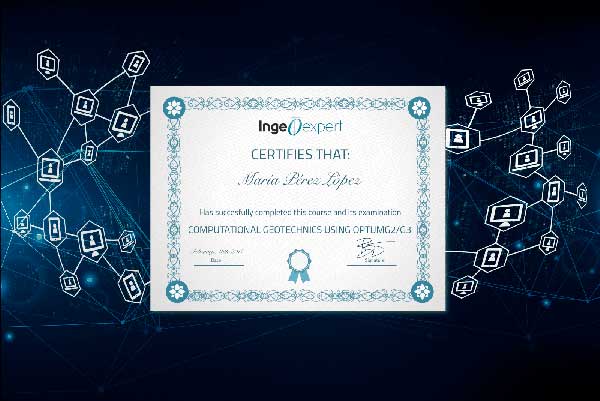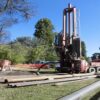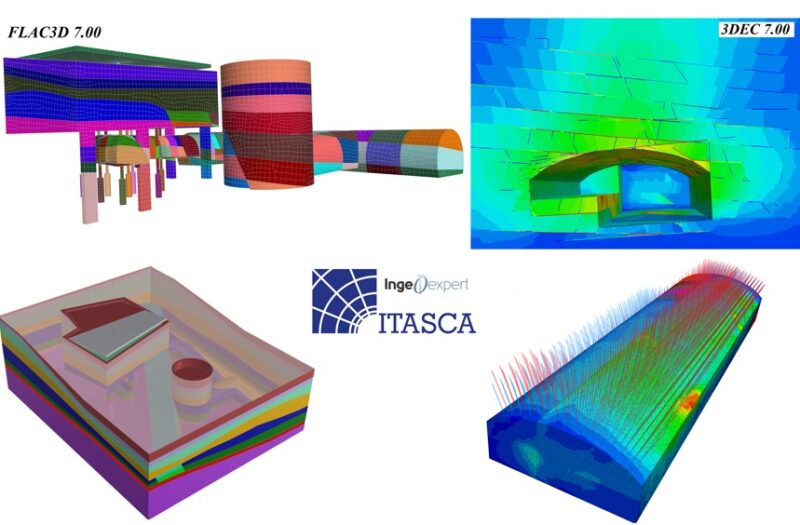Advanced Numerical Modelling in FLAC3D and 3DEC
Online course |
|
50 hours / 6 weeks |
|
|
Dates: 5th of August to 16th of September |
| Standard | Unemployed Or Student |
| $367 | $292 |
Full-featured versions of FLAC3D and 3DEC software included
In collaboration with ITASCA
Introduction
Embark on a journey into the realm of three-dimensional (3D) nonlinear geomechanical numerical models, featuring Itasca’s powerful tools 3DEC and FLAC3D. In the pursuit of optimized designs and solutions to complex challenges posed by irregular geometries, geological structures (e.g., dykes, faults), varying stress regimes, and complex scale-dependent constitutive behavior of rock masses, these advanced models become indispensable.
As the demand for advanced numerical modeling in ground-structure interaction analysis grows, it becomes crucial to choose the right modeling tool, represent geometries with high-quality meshes, select the most representative constitutive model, and interpret results with precision. However, mastering these fundamental aspects through self-learning or relying solely on extensive tool documentation can be overwhelming, time-consuming, and, in many cases, impractical. This course serves as a guide, offering a practical understanding of the advanced numerical modeling process in FLAC3D and 3DEC. The focus extends to leveraging the FISH programming language embedded in these programs, along with creating intricate geometries using Rhinoceros and Griddle.
Gain the insights needed to navigate the complexities of advanced numerical modeling, ensuring a solid foundation for safer designs. This course is tailored to provide an effective and efficient learning experience, particularly beneficial for those new to the world of modeling.
Objectives
It is anticipated that participants will acquire the necessary skills to tackle challenging engineering problems through advanced numerical modeling. Therefore, this course:
- Introduces the procedure for estimating and coding rock mass parameters for FLAC3D and 3DEC, essential in advanced constitutive models
- Establishes a step-by-step 3DEC model setup and analysis throughout a case example of a cavern constructed sequentially in a hard rock mass environment
- Presents the procedure of FLAC3D modelling via a case example of shaft-adit-tunnel excavated in a soft ground environment, and
- Provides students with the basic practical knowledge of creating complex geometries in Rhinoceros required for modelling in FLAC3D as well as coding in FISH for 3DEC simulations
Limited places.
Module 1 – Overview of Estimating Parameters for Continuum and Discontinuum Modelling & An Introduction to Coding in Fish:
An Introduction to:
- – Analyzing rock failure mechanisms, numerical modelling in rock engineering, adopting rock mass parameters for FEM, adopting rock mass parameters for DEM
- – Basic commands for model setup in FLAC3D and 3DEC as well as Utilising FISH functions for an automated simulation
Module 2 – Coding for a Sequenced Excavation in 3DEC (Part I – Input Parameters and Geometry):
Writing codes and fish functions in 3DEC to:
- – Input Geometrical and Geomechanical Properties
- – Create the Geometry
Module 3 – Coding for a Sequenced Excavation in 3DEC (Part II – Insitu State and Excavation):
Writing codes and fish functions in 3DEC to:
- – Solve to the In-situ Equilibrium State
- – Loop Over the Excavations Sequences and Install the Support System (Patterned Rock Bolts)
Module 4 – Coding for a Sequenced Excavation in FLAC3D (Part I – Model Setup):
Introducing a workflow for Meshing a Geometry Created in Rhino
Writing codes and fish functions in FLAC3D to:
- Import The Meshed Geometry and setup the model
Module 5 – Coding for a Sequenced Excavation in FLAC3D (Part II – Insitu State and Excavation):
Writing codes and fish functions in FLAC3D to:
- – Solve to the In-situ Equilibrium State
- – Loop Over the Excavations Sequences and Install the Support System
- Assignments: One question per module (Optional to Submit)
- Webinars: Three Live webinars on Week 2, Week 3, and Week 4
- Limitations: Due to confidentiality constraints, specific case studies for calibration/validation are not covered. The two examples shared in the course serve as valuable learning experiences derived from real-world cases, but practical applications in calibration/validation may vary based on the unique characteristics of each engineering project.
Dr. Ali Keneti
Ali Keneti (PhD, P.Eng.) is a Principal Engineer (Geomechanics and Tunnels) with 17 years of professional and research experience in geomechanical aspects of Civil Infrastructures and Resources Engineering in North America and Austrasia (e.g., Tunneling, Hydropower, Mining, and Pipeline disciplines). He is competent in advanced numerical modelling and experienced in geohazard risk assessment, rock mass characterization, and geo-structures stability/interaction analysis. Such technical breadth and a diverse research capability have provided Dr. Keneti with a unique multidisciplinary background for challenging undertakings in geo-engineering. He is a registered professional engineer in Canada (P. Eng. – British Columbia), co-author of several scientific articles and an invited reviewer for renowned international journals in Geomechanics.
Dr. Keneti brings not only extensive industry experience but also a dynamic teaching approach to the classroom. His teaching style emphasizes hands-on learning, encouraging active participation from students. By incorporating real-world examples from his rich professional background, Dr. Keneti creates an engaging and practical learning experience. He is dedicated to cultivating a collaborative environment where students feel empowered to explore and apply advanced numerical modeling concepts in the context of geomechanics. His commitment to staying abreast of the latest advancements in the field ensures that students benefit from cutting-edge knowledge and innovative teaching methodologies.
The course is delivered online through our easy-to-use Virtual Campus platform. For this course, a variety of content is provided including:
– eLearning materials
– Videos
– Interactive multimedia content
– Live webinar classes
– Texts and technical articles
– Case studies
– Assignments and evaluation exercises
Students can download the materials and work through the course at their own pace. We regularly update this course to ensure the latest news and state-of-the-art developments are covered, and your knowledge of the subject is current.
Live webinars form part of our course delivery. These allow students and tutors to go through the course materials, exchange ideas and knowledge, and solve problems together in a virtual classroom setting. Students can also make use of the platform’s forum, a meeting point to interact with tutors and other students.
The tutoring system is managed by email. Students can email the tutor with any questions about the course and the tutor will be happy to help.
While a passion for engineering and enthusiasm for tackling 3D challenges are the primary prerequisites, a basic understanding of rock mechanics and geotechnical engineering is beneficial. Exposure to a modeling environment, whether 2D or 3D, is also advantageous. This course provides an overview of basic commands in the initial module, making it accessible for those new to FLAC3D and 3DEC, or as a refresher for experienced individuals. While no prior exposure is mandatory, students with programming enthusiasm will find it particularly rewarding. To enhance your foundational knowledge, additional resources are provided, including useful links for self-paced learning. If you are new to geomechanics and tunnelling, it’s recommended to consider taking this course with or after completing Ingeoexpert’s offerings on ‘Ground support for tunnels in rock’ and ‘Soft ground tunnelling’ courses.
Once a student finishes the course and successfully completes the assignments and evaluation tests, they are sent an accreditation certificate. The certificate is issued by Ingeoexpert to verify that the student has passed the course. It is a digital certificate that is unique and tamper-proof – it is protected by Blockchain technology. This means it is possible for anyone to check that it is an authentic, original document.
You will be able to download the certificate in an electronic format from the Virtual Campus platform. The certificate can be forwarded by email, shared on social networks, and embedded on websites. To see an example, click here.
In today’s dynamic engineering landscape, proficiency in advanced numerical modeling using tools like FLAC3D and 3DEC has become a cornerstone skill. Itasca’s software, renowned for its versatility and precision, is in high demand across the globe. These tools offer a unique advantage with their fully controllable coding capabilities, providing engineers with unprecedented flexibility in crafting models tailored to specific project requirements.
As major engineering firms increasingly prioritize advanced numerical modeling for ground-structure interaction analysis, individuals well-versed in conducting and interpreting 3D models in geotechnical engineering stand out as key assets. The applicability of Itasca’s tools extends beyond entry-level roles; senior professionals equipped with advanced modeling skills find themselves better positioned to manage and streamline the design process effectively.
By acquiring expertise in Itasca’s state-of-the-art software, you not only enhance your employability but also contribute to addressing the evolving challenges in geomechanics, making you an invaluable asset in the competitive job market.
Full-featured versions of FLAC3D and 3DEC software included
In collaboration with ITASCA
Introduction
Embark on a journey into the realm of three-dimensional (3D) nonlinear geomechanical numerical models, featuring Itasca’s powerful tools 3DEC and FLAC3D. In the pursuit of optimized designs and solutions to complex challenges posed by irregular geometries, geological structures (e.g., dykes, faults), varying stress regimes, and complex scale-dependent constitutive behavior of rock masses, these advanced models become indispensable.
As the demand for advanced numerical modeling in ground-structure interaction analysis grows, it becomes crucial to choose the right modeling tool, represent geometries with high-quality meshes, select the most representative constitutive model, and interpret results with precision. However, mastering these fundamental aspects through self-learning or relying solely on extensive tool documentation can be overwhelming, time-consuming, and, in many cases, impractical. This course serves as a guide, offering a practical understanding of the advanced numerical modeling process in FLAC3D and 3DEC. The focus extends to leveraging the FISH programming language embedded in these programs, along with creating intricate geometries using Rhinoceros and Griddle.
Gain the insights needed to navigate the complexities of advanced numerical modeling, ensuring a solid foundation for safer designs. This course is tailored to provide an effective and efficient learning experience, particularly beneficial for those new to the world of modeling.
Objectives
It is anticipated that participants will acquire the necessary skills to tackle challenging engineering problems through advanced numerical modeling. Therefore, this course:
- Introduces the procedure for estimating and coding rock mass parameters for FLAC3D and 3DEC, essential in advanced constitutive models
- Establishes a step-by-step 3DEC model setup and analysis throughout a case example of a cavern constructed sequentially in a hard rock mass environment
- Presents the procedure of FLAC3D modelling via a case example of shaft-adit-tunnel excavated in a soft ground environment, and
- Provides students with the basic practical knowledge of creating complex geometries in Rhinoceros required for modelling in FLAC3D as well as coding in FISH for 3DEC simulations
Limited places.
Module 1 – Overview of Estimating Parameters for Continuum and Discontinuum Modelling & An Introduction to Coding in Fish:
An Introduction to:
- – Analyzing rock failure mechanisms, numerical modelling in rock engineering, adopting rock mass parameters for FEM, adopting rock mass parameters for DEM
- – Basic commands for model setup in FLAC3D and 3DEC as well as Utilising FISH functions for an automated simulation
Module 2 – Coding for a Sequenced Excavation in 3DEC (Part I – Input Parameters and Geometry):
Writing codes and fish functions in 3DEC to:
- – Input Geometrical and Geomechanical Properties
- – Create the Geometry
Module 3 – Coding for a Sequenced Excavation in 3DEC (Part II – Insitu State and Excavation):
Writing codes and fish functions in 3DEC to:
- – Solve to the In-situ Equilibrium State
- – Loop Over the Excavations Sequences and Install the Support System (Patterned Rock Bolts)
Module 4 – Coding for a Sequenced Excavation in FLAC3D (Part I – Model Setup):
Introducing a workflow for Meshing a Geometry Created in Rhino
Writing codes and fish functions in FLAC3D to:
- Import The Meshed Geometry and setup the model
Module 5 – Coding for a Sequenced Excavation in FLAC3D (Part II – Insitu State and Excavation):
Writing codes and fish functions in FLAC3D to:
- – Solve to the In-situ Equilibrium State
- – Loop Over the Excavations Sequences and Install the Support System
- Assignments: One question per module (Optional to Submit)
- Webinars: Three Live webinars on Week 2, Week 3, and Week 4
- Limitations: Due to confidentiality constraints, specific case studies for calibration/validation are not covered. The two examples shared in the course serve as valuable learning experiences derived from real-world cases, but practical applications in calibration/validation may vary based on the unique characteristics of each engineering project.
Dr. Ali Keneti
Ali Keneti (PhD, P.Eng.) is a Principal Engineer (Geomechanics and Tunnels) with 17 years of professional and research experience in geomechanical aspects of Civil Infrastructures and Resources Engineering in North America and Austrasia (e.g., Tunneling, Hydropower, Mining, and Pipeline disciplines). He is competent in advanced numerical modelling and experienced in geohazard risk assessment, rock mass characterization, and geo-structures stability/interaction analysis. Such technical breadth and a diverse research capability have provided Dr. Keneti with a unique multidisciplinary background for challenging undertakings in geo-engineering. He is a registered professional engineer in Canada (P. Eng. – British Columbia), co-author of several scientific articles and an invited reviewer for renowned international journals in Geomechanics.
Dr. Keneti brings not only extensive industry experience but also a dynamic teaching approach to the classroom. His teaching style emphasizes hands-on learning, encouraging active participation from students. By incorporating real-world examples from his rich professional background, Dr. Keneti creates an engaging and practical learning experience. He is dedicated to cultivating a collaborative environment where students feel empowered to explore and apply advanced numerical modeling concepts in the context of geomechanics. His commitment to staying abreast of the latest advancements in the field ensures that students benefit from cutting-edge knowledge and innovative teaching methodologies.
The course is delivered online through our easy-to-use Virtual Campus platform. For this course, a variety of content is provided including:
– eLearning materials
– Videos
– Interactive multimedia content
– Live webinar classes
– Texts and technical articles
– Case studies
– Assignments and evaluation exercises
Students can download the materials and work through the course at their own pace. We regularly update this course to ensure the latest news and state-of-the-art developments are covered, and your knowledge of the subject is current.
Live webinars form part of our course delivery. These allow students and tutors to go through the course materials, exchange ideas and knowledge, and solve problems together in a virtual classroom setting. Students can also make use of the platform’s forum, a meeting point to interact with tutors and other students.
The tutoring system is managed by email. Students can email the tutor with any questions about the course and the tutor will be happy to help.
While a passion for engineering and enthusiasm for tackling 3D challenges are the primary prerequisites, a basic understanding of rock mechanics and geotechnical engineering is beneficial. Exposure to a modeling environment, whether 2D or 3D, is also advantageous. This course provides an overview of basic commands in the initial module, making it accessible for those new to FLAC3D and 3DEC, or as a refresher for experienced individuals. While no prior exposure is mandatory, students with programming enthusiasm will find it particularly rewarding. To enhance your foundational knowledge, additional resources are provided, including useful links for self-paced learning. If you are new to geomechanics and tunnelling, it’s recommended to consider taking this course with or after completing Ingeoexpert’s offerings on ‘Ground support for tunnels in rock’ and ‘Soft ground tunnelling’ courses.
Once a student finishes the course and successfully completes the assignments and evaluation tests, they are sent an accreditation certificate. The certificate is issued by Ingeoexpert to verify that the student has passed the course. It is a digital certificate that is unique and tamper-proof – it is protected by Blockchain technology. This means it is possible for anyone to check that it is an authentic, original document.
You will be able to download the certificate in an electronic format from the Virtual Campus platform. The certificate can be forwarded by email, shared on social networks, and embedded on websites. To see an example, click here.
In today’s dynamic engineering landscape, proficiency in advanced numerical modeling using tools like FLAC3D and 3DEC has become a cornerstone skill. Itasca’s software, renowned for its versatility and precision, is in high demand across the globe. These tools offer a unique advantage with their fully controllable coding capabilities, providing engineers with unprecedented flexibility in crafting models tailored to specific project requirements.
As major engineering firms increasingly prioritize advanced numerical modeling for ground-structure interaction analysis, individuals well-versed in conducting and interpreting 3D models in geotechnical engineering stand out as key assets. The applicability of Itasca’s tools extends beyond entry-level roles; senior professionals equipped with advanced modeling skills find themselves better positioned to manage and streamline the design process effectively.
By acquiring expertise in Itasca’s state-of-the-art software, you not only enhance your employability but also contribute to addressing the evolving challenges in geomechanics, making you an invaluable asset in the competitive job market.
23 reviews for Advanced Numerical Modelling in FLAC3D and 3DEC
More info
Finish this course and get a certificate based on Blockchain
Advanced Numerical Modelling in FLAC3D and 3DEC


Blockchain technology makes the certificate incorruptible, enabling companies to verifiy its autenticity.
Advanced Numerical Modelling in FLAC3D and 3DEC
| $367 | $292 | |
| Get more information |






Alie Assefa Ashebir –
I really appreciate the way the Numerical Modelling has been taught in practice. I have got lots from Dr. Keneti and I would like to extend my deepest Thanks for him and the Campus team as a whole.
Macgyver Condorpusa Cordova –
El presente curso fue muy pero muy bueno.
Albert Sánchez –
My gratitude to Ali Keneti (for his great experience and knowledge) and Ingeoexpert for the magnificient course “Advanced Numerical Modelling in FLAC3D and 3DEC”. Of course if they do a similar course. I’ll be there.
Yit Haw Toi –
Highly recommended for anyone who is interested in numerical modelling in rock. Excellent course.
Mohammad Mahtab Uddin –
This course is recommended to users who already have some experience in using Itasca codes. Advanced beginners will be able to take away a lot.
Zakieh Harif –
The course was great and beneficial. Having Webinars for Q&A was also helpful.
RAUL RODOLFO POZO GARCIA –
I found the course very useful, it has allowed me to acquire knowledge about 3D modeling in softwares that are usually difficult to understand, despite this it has been clearly explained by the instructor
Cetin Sahin –
All good!
Tuncer Akilli –
I appreciate all the course contents prepared for both 3DEC and FLAC3D of the most sophisticated DEM and FEM geomechanics software codes in the underground tunnelling industry, aiming for real site problems considering subtle details with regard to explicit numerical modelling. Most importantly, I acknowledge the time and effort Dr. Keneti has put in the course.
HAZEL GONZÁLEZ –
La estructura del curso te lleva desde un ligero repaso los conceptos teóricos básicos, en verdad cubre todo lo necesario para comenzar a hacer modelos para el trabajo en 3Dec .
Ernesto Torres Matienzo –
Well was really fun learning as a new challenge in english this kind of course, which is not easy but complete and full review of one of the most importants topics in mining and geomechanical jobs today.
Jessie Huang –
Well-structured modules with helpful resources to help students easily understand the concept and features of Flac3D and 3Dec. Examples were given to go through the modeling process of tunnel excavation from start to end,helping students to learn about the use of software in a practical manner. The provided codes are another great self-learning resource with clear and concise notes. Really enjoyed the course and appreciated the effort that the professor put into preparing this!
Amanda Huang –
The course has been well organized and delivered by Dr Ali Keneti. The contents provide really good coverage on the background, theory and implementation of both discontinuum and continuum numerical modelling codes. The examples are very useful for geotechnical engineers to be directly implemented in their project designs.
Brad Panton –
Nice to see experts such as Dr. Keneti being so willing to distill the use of these complex codes in such a digestible / practical way. Enjoyed the course and Ali’s collaborative / inclusive approach.
Aaron Chagwedera –
The course was well taught. All aspects of numerical modelling for complex geometries were covered. The Professor was always available for the students, his vast knowledge and experience towards the subject equipped me with high level knowledge of numerical modelling in FLAC3D and 3DEC.
Yusuf Soliman –
The courses are very beneficial and provide a large amount of valuable information. I learnt a lot from the professor.
Hamidreza Ashtari –
This course is highly beneficial for individuals with introductory knowledge of FLAC3D and 3DEC, particularly in the context of tunneling. Dr. Kenneti, with his extensive support and expertise, offers valuable insights. I wholeheartedly recommend this course to everyone interested in expanding their understanding in this field.
Marceli Granja –
Dr. Ali Keneti is such an excellent teacher. I love his technical presentations and communication skills. I greatly recommend it to all passionate tunnel engineers.
Andre Ginting –
This is the second time I took the course within Ingeoexpert, Really love the way courses are brought to student!
Alejandro Gómez Gómez –
I’m not an advanced user of FLAC3D and 3DEC but the course helps me to understand basic and advanced concepts. Really helps.
Omar Tharwat –
Learning from Dr. Keneti’s immense expertise and knowledge was an informative experience. The course tackles the most complex geomechanics software code (FLAC3D, 3DEC) from theory to practice using practical applications and many code examples, and even covers subtle details and diverse approaches in numerical modeling with well-structured content and guidance. My deepest gratitude to Dr. Keneti for the time and effort he has put into the course, as well as his continuous support.
Julius Emmanuel EMURIAT –
Generally good!
prakash kumar –
I am delighted by the way professors teach.